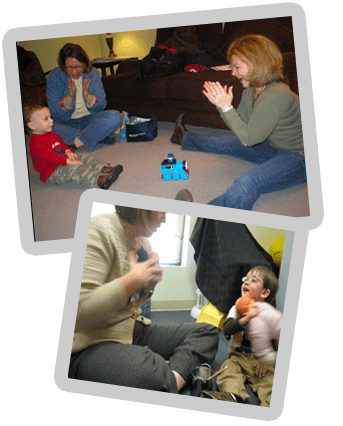“Play is … the principal business of childhood.”
—Jerome Bruner
We have had the opportunity to visit the homes of many families raising children with Fragile X syndrome (FXS). One of the common sites we encounter is a playroom or play area chock-full of every toy known to man. The parents always remark, “I bought all these toys, but he won’t play with any of them!” This exasperation is likely familiar to many readers.
Perhaps the child has one or two favorite toys, but even then, the way he plays may be more limited than observed with typical children. Take Matteo, a 2-year-old boy we visited, who would unload the toy bin and then hide on the couch, feeling overwhelmed. For him, just taking the toys out reached the limit of his ability to play with them.
Then there is our friend Nick, an 8-year-old who likes to push cars, but after doing this for several turns, he has no idea how to change it up, keep it interesting, or try something new.

Individuals with Fragile X syndrome often exhibit limited play skills throughout childhood and even into adulthood. Their parents and caregivers often realize that they need to move them from the couch and the joystick to more active exploration and joyful play, but are at a loss for how to do so. This is a problem because research has shown us definitively that besides play being fun, children and adults develop and refine many life skills through play.
Play allows children to use their creativity while developing their imagination, dexterity, and physical, cognitive, and emotional strength, as noted in the American Academy of Pediatricians report, The Importance of Play in Promoting Healthy Child Development and Maintaining Strong Parent-Child Bonds.
Play is not only a means of learning but a primary way for individuals to manage stress. Play also helps build relationships between children and their parents, caregivers, and teachers. During play, adults have the chance to observe a child’s behaviors and participate in their world. Playtime offers parents and other caregivers a great way to gain insight into a child’s perceptions and feelings, and how they understand the world.
However, play is difficult for those who have Fragile X syndrome. Understanding why play is so challenging leads to an understanding of how to address it. For individuals with Fragile X syndrome, one of the most apparent reasons is the presence of motor planning difficulties. Children with FXS may not be able to figure out what to do with a toy (ideation), how to start (initiation), or how to manipulate the toy (execution). All of these are aspects of the motor planning process.
Despite their motor planning struggles and other difficulties with play skill development, we know that individuals with Fragile X syndrome have strong imitation skills. They also are incidental learners. We can use these talents to help with play development.
From our experiences working with hundreds of children with Fragile X syndrome, we offer these suggestions to help guide and support play development.
Children with Fragile X syndrome often cannot come up with an idea for what to do with a toy. We have to be their model. We have to demonstrate simple play schemas that they can imitate and learn. What is a schema? It’s an idea or action that can be used for fun. It can be a simple, sensorimotor exercise such as throwing a ball, or it can be more complex, such as pretend-eating or being a superhero. Or it can be inventive and creative, such as pretending a box is a pirate ship, and a twig is your sword. Schemas allow for expansion from simple to complex; they are the building blocks of play
Being dramatic and silly helps here, as does using a rhythmic voice and the “same” or similar script. One schema might be to take the child’s favorite toys (say, three plastic dinosaurs), get yourself an identical set so each of you can play, and demonstrate the dinosaurs going to sleep, waking up, and eating breakfast. As the child masters and imitates this schema, you can add to it: The dinosaurs can take a ride in a truck to get groceries, or go out to a restaurant for breakfast (after cleaning their rooms, of course!). Remember, having an identical set of toys/objects for each of you is important.
Expanding a schema involves observing what the child is doing and then modeling or providing supports (props, scripts, etc.) that add to the schema and make it more meaningful, lengthier, more engaging, and generally more fun.
Play comes from understanding the various “roles” played by each “actor.” An example is hide-and-seek, in which there are the distinct roles of “hider” and “seeker.” The game cannot commence or be successful unless a child can pick up on and then act out these roles.
In pretend play, think of 3-5 activities that the prop does in real life, then model each action with a clear “role” for the child to partake in, e.g., dogs, cars, and cooking.
Get an adult or other child to model each role, then work with your child until the roles are mastered. Use video modeling to further model ideas, roles, and schemas.
In computer games, know the game well enough that you can help define a clear “role” and structure for your child to ensure success.
In pretend play, think of 3-5 activities that the prop does in real life, then model each action with a clear “role” for the child to partake in, e.g., dogs, cars, and cooking. Get an adult or other child to model each role, then work with your child until the roles are mastered. Use video modeling to further model ideas, roles, and schemas.
Exploring and expanding the possibilities of the interaction or object allows the child to understand the potential for action and fun. Play is the child making these possibilities happen; it starts as exploration but expands into more purposeful action. If the child has limited schemas, start by following her lead, fostering exploration, and modeling play.
Imitation is the backdrop for most schema acquisition. Since children with Fragile X syndrome often have strength in imitation, this provides a natural means for fostering play skills. Incidental learning opportunities, peer play, and a “floortime” approach can all be used as vehicles for play development. Floortime refers to a specific technique to follow children’s lead using their interest areas, to engage and help them master their social, emotional, and cognitive worlds. This usually occurs when engaged in playful interactions on the floor, but goes on to include conversations and interactions in other places.
Therapists should utilize a play-based approach, using the child’s interests, because it capitalizes on the strengths of children with FXS while minimizing the direct instruction/demand that can trigger hyperarousal and anxiety, and thus limit the learning that comes from play.
Remember to manage excitement and hyperarousal as you play. Establish a shared effect and connection with the child and use this connection to settle her down before letting the play come to an end.
Play-Related Books
- Playing, Laughing, and Learning with Children on the Autism Spectrum, by Julia Moore
- Giggle Time—Establishing the Social Connection: A Program to Develop the Communication Skills of Children With Autism, Asperger Syndrome and PDD, by Susan Aud Sonders.
- Play in Occupational Therapy for Children, by Diane Parham Trigg and Linda S. Fazio
- Early Start Denver Model for Young Children with Autism, by Sally J. Rogers and Geraldine Dawson
- Peer Play and the Autism Spectrum: The Art of Guiding Children’s Socialization and Imagination, by Pamela J. Wolfberg






